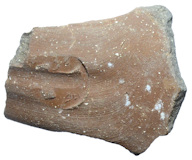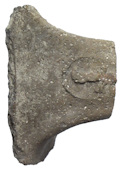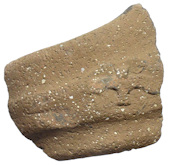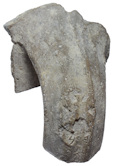Fine Coins Showcase
Antiquities Showcase
Hide empty categories
Shop Search
Shopping Cart
My FORVM
Contact Us
About Forum
Shopping at Forum
Our Guarantee
Payment Options
Shipping Options & Fees
Privacy & Security
Forum Staff
Selling Your Coins
Identifying Your Coin
FAQs
zoom.asp
Home ▸ Catalog ▸ |Antiquities| ▸ |Antiquities by Type| ▸ |Seals||View Options:   | | | | | | Both the objects used to make impressions and the impressions themselves are referred to as seals. Seal impressions served as a signature of the owner of the seal. Seals used to make impressions include cylinder seals and stamp seals. Often these seals are holed for stringing and some were probably never used to make impressions, but were rather worn as amulets. The most common form of seal impression is the bulla. A bulla (plural, bullae), is a lump of clay or lead molded around a cord and stamped with a seal that identifies the sender. With a bulla in place a container cannot be violated without visible damage to either the bulla or the cord, thereby ensuring the contents remain tamper-proof until they reach their destination. |


| "LMLK handles" are from pottery jars which were stamped before firing with a seal that includes either a four-winged scarab or a two-winged disc, the ancient Hebrew phrase spelled Lamed-Mem-Lamed-Kaf, commonly pronounced "L'melekh," meaning "belonging to the king" above, and the name of one of the cities that served as a distribution center: HBRN (Hebron), ZP (Ziph), SWKH (Socoh), or MMST below. This handle is stamped with a two-winged disc and Het-Bet-Resh-Nun (HBRN = Hebron) below. For more information see The LMLK Research Website - http://www.lmlk.com/research/index.html. |  |
Kingdom of Judah, First Temple Period, L'melekh (LMLK) Pottery Handle, c. 700 B.C.


| "LMLK handles" are from pottery jars which were stamped before firing with a seal that includes either a four-winged scarab or a two-winged disc, the ancient Hebrew phrase spelled Lamed-Mem-Lamed-Kaf, commonly pronounced "L'melekh," meaning "belonging to the king" above, and the name of one of the cities that served as a distribution center: HBRN (Hebron), ZP (Ziph), SWKH (Socoh), or MMST below. This handle is stamped with a two-winged disc and Zayin-Fay (ZP = Ziph) below. For more information see The LMLK Research Website - http://www.lmlk.com/research/index.html. |  |
Kingdom of Judah, First Temple Period, L'melekh (LMLK) Pottery Handle, c. 700 B.C.


| "LMLK handles" are from pottery jars which were stamped before firing with a seal that includes either a four-winged scarab or a two-winged disc, the ancient Hebrew phrase spelled Lamed-Mem-Lamed-Kaf, commonly pronounced "L'melekh," meaning "belonging to the king" above, and the name of one of the cities that served as a distribution center: HBRN (Hebron), ZP (Ziph), SWKH (Socoh), or MMST below. This handle is stamped with a two-winged disc and Mem-Mem-Shin-Tau (MMST) below. For more information see The LMLK Research Website - http://www.lmlk.com/research/index.html. |  |
Kingdom of Judah, First Temple Period, L'melekh (LMLK) Pottery Handle, c. 700 B.C.


| "LMLK handles" are from pottery jars which were stamped before firing with a seal that includes either a four-winged scarab or a two-winged disc, the ancient Hebrew phrase spelled Lamed-Mem-Lamed-Kaf, commonly pronounced "L'melekh," meaning "belonging to the king" above, and the name of one of the cities that served as a distribution center: HBRN (Hebron), ZP (Ziph), SWKH (Socoh), or MMST below. This handle is stamped with a four-winged scarab and Het-Bet-Resh-Nun (HBRN = Hebron) below. For more information see The LMLK Research Website - http://www.lmlk.com/research/index.html. |  |
Ancient Near Eastern Cylinder Seals, From the Marcopoli Collection


Ex Libris Alex G. MalloyBK21982. Ancient Near Eastern Cylinder Seals, From the Marcopoli Collection by Beatrice Teissier, 407 pages, 643 seals, illustrated, hardcover, dust cover wear, international shipping at actual cost of shipping, priced below FORVM's cost!; $320.00 (€300.80)
Byzantine, Lead Bulla Seal, c. 6th Century A.D.


Reading a block monogram of such complexity as on the present Byzantine seal can be maddening, like a quadratic or more complex polynomial equation whose solutions are all found to be reasonable. The inherent ambiguity of many block monograms may have been one reason why they fell out of favor during the seventh century A.D. Nevertheless, through patient study, some possible clues have been squeezed out of ours. The monogram may in fact combine a personal name with the office of a bishop (written in the genitive, EΠICKOΠOY, or "of the bishop") or perhaps even an archbishop (APXIEΠICKOΠOY). The person's name is a much trickier question with multiple possibilities, including Markou, Mariou, Marianou, Maurikiou, Eukarpiou, or even Kyprianou (all transliterated into English in genitive form). Another, less probable, possibility is an unidentified eparch (bishop of an eparchy or diocese).BZ114045. Lead bulla (tag seal), cf. Zacos BLS 1208 (for very similar obv.); DOCBS BZS.1951.31.5.3062 (for similar seal with block monogram), Choice gVF, attractive, yellow oxide patina, weight 10.259 g, maximum diameter 22.1 mm, die axis 330o, c. 6th century A.D.; obverse facing bust of Virgin Hodeghetria, nimbate, wearing tunic and maphorion, holding infant Christ on her left arm/shoulder, nimbate, wearing tunic and himation, dove (i.e., the Holy Spirit) above, cross pattée behind; reverse complex block monogram, containing the letters A, Y, E (lunate), I, K, Π, Ο, P, C, and M and/or X, and possibly N; extremely rare; $200.00 (€188.00)
Byzantine Empire, Lead Bulla Seal, Leo Nikerites, Doux, 11th - 12th Century A.D.


There is much we could say about this Byzantine eunuch general who served under Emperor Alexios I Komnenos. On our seal, the title of doux (from which English "duke" is derived) was just one of many high-ranking positions enjoyed by Nikerites during his long career, which included posts in the Peloponnese (as anagrapheus), Bulgaria, & Cyprus. However, for our current infatuation in solar eclipses, this anecdote from Anna Komnene's Alexiad overshadows all others!
"In the course of the discussion a certain Nicolas, one of the Emperor's [Alexios'] secretaries, came up to him and whispered in his ear, 'You may expect an eclipse of the sun to take place today [16 February 1086],' and on the Emperor's expressing a doubt, he swore with an oath that he was not lying. Then the Emperor, with his habitual quick-wittedness, turned to the Scythians and said, 'I appoint God as judge; and if a sign appears in the heavens this day, you will know for a surety that I have good reason for suspecting, and therefore not receiving, your embassy because your leaders are not sincere in their overtures for peace. If, however, no sign appears, I shall stand convicted of having been wrong in my surmise.' Before two hours had passed, the light of the sun failed, and the whole of its disc was darkened by the moon's passing over it. At that sight the Scythians were terrified, and the Emperor handed them over to Leo Nicerites (he was a eunuch, brought up among the soldiers from babyhood, and much respected) and ordered him to take a sufficient guard and conduct them to the Queen of Cities. And Leo started very willingly on the road to Constantinople. But the barbarians who were throughout intent on regaining their liberty, slew the guards who were keeping a very careless watch over them when they reached little Nicaea, and returned by devious paths to those who had sent them. Nicerites with three others escaped with difficulty and rejoined the Emperor at Goloë."BZ113298. Lead bulla (tag seal), DOCBS Online BZS.1951.31.5.1259 (same boulloterion or dies); Wassiliou-Seibt BSML II 2526; CGB Istanbul 2.204; Seibt BBÖ I p. 226, 10, VF, uneven, off-centered impression, uniform yellow oxide patina with spots of roughness, remnants of channel for cord visible, weight 10.582 g, maximum diameter 22.1 mm, c. 1100 A.D.; obverse [CΦΓA]/ΓIC Λ[E]/ONTO[C] (sic!; "Seal of Leo/Leon") in three lines, a cross above (off blank), all within dotted border; reverse ΔOV/KOC TOV / [N]IKEPI/TOV (of Duke Nikerites) in three lines within dotted border; ex Time Machine, with a historical connection between Nikerites and a solar eclipse!; very rare; $180.00 (€169.20)
Roman, Conical Lead Bulla Seal, c. Late 3rd Century A.D., ANAK...


AR83616. Lead bulla (tag seal), cf. Boersema-Dalzell 157 (very similar size and style with inscription ΠA-NΦV), gVF, weight 3.13 g, maximum diameter 13.1 mm, die axis 0o, obverse bare-headed, draped male bust right, ANAK... upward behind; reverse conical with rounded top, pierced for cord; $90.00 (€84.60)
Roman, Intaglio Engraved Gem Stone, 1st - 3rd century A.D.


AS90832. Antike Gemmen Deutschen -, Marlborough -; Intaglio engraved translucent red carnelian, weight 0.406 g, maximum diameter 11.2 mm, Dioscuri standing facing, heads confronted, each holds a bow(?) in inner hand and spear in outer hand, star above each head, crescent moon with horns up above center, from The Jimi Berlin Caesarea Collection, found at Caesarea, Israel; SOLD
CLICK HERE TO SEE MORE FROM THIS CATEGORY - FORVM's PRIOR SALES



REFERENCES
Page created in 1.391 seconds.








